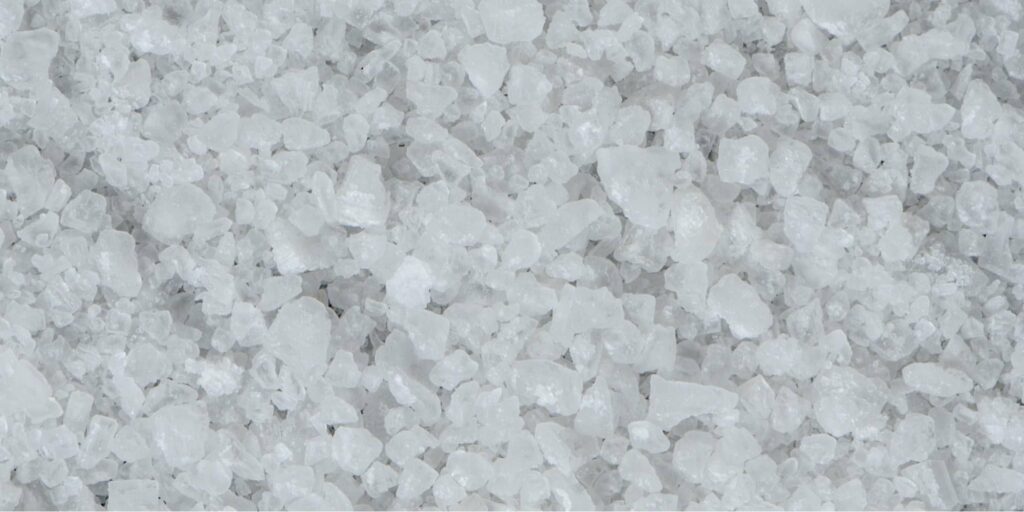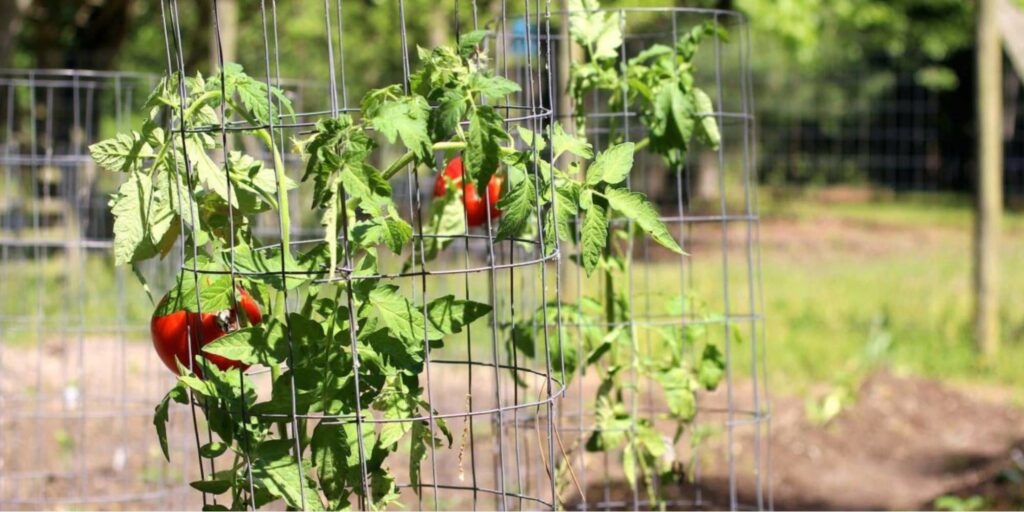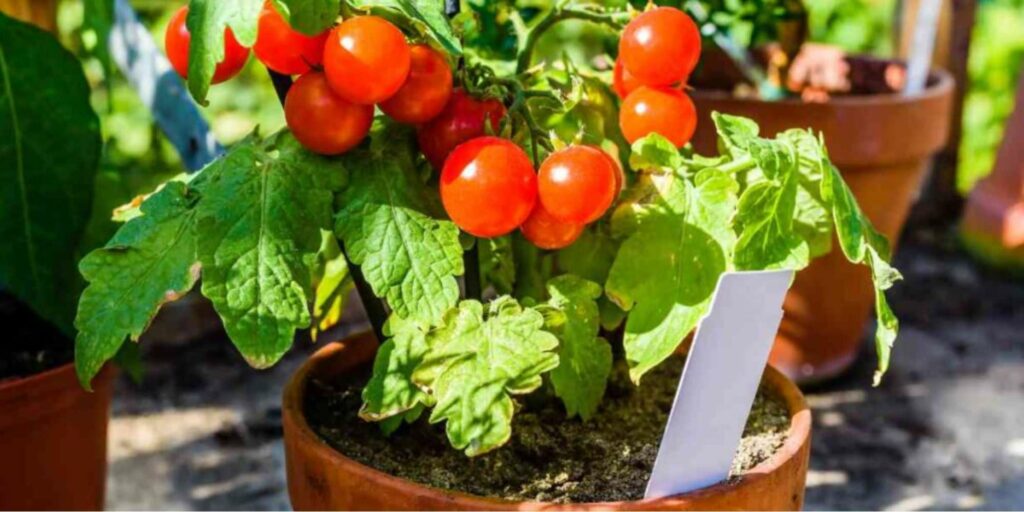Using Epsom salt for tomato plants has been all the rage these days and with good reason. So, if you’re thinking about adding Epsom salt to your tomato care routine, keep reading to learn all the benefits it can bring to your garden!
Everything You Need to Know About Using Epsom Salt for Tomato Plants
Epsom salt is great for tomato plants suffering from magnesium deficiency-related issues such as yellowing leaves, curling foliage, browning, blemishes, poor germination, slow growth, and lack of flavor.
To use, mix 2 tablespoons of Epsom salt with a gallon of water. Spray on the foliage or water the soil.
Below is a summary of the benefits of using Epsom salt for tomato plants, and how to use it to address the problem:
| Benefits | How To |
| Fix yellowing leaves | Mix a gallon of water with 2 tablespoons of Epsom salt. Either mist the leaves and stem or use the solution in replacement of regular watering once a month. |
| Improve seed germination | Mix a teaspoon of Epsom salt with a watering can’s worth of water. Use this mixture to water your newly sown seeds. |
| Reduce tomato blemishes | Mix a gallon of water with 2 tablespoons of Epsom salt. Either mist the leaves or water the soil with the solution for better absorption. Repeat every two weeks. |
| Boost tomato plant growth | Sprinkle a cup of Epsom salt evenly all over the plot. Mix the salt into the soil for easier absorption to make it easier for your plants to take in all the nutrients. |
| Improve flavor | Mix 2 tablespoons of Epsom salt with a gallon of water. Use the solution in replacement for regular watering. Repeat every two weeks. |
What’s Epsom salt?

Epsom salt is a natural mineral compound that’s rich in magnesium and sulfur. It’s also commonly called “magnesium sulfate”
This micronutrient is well-known for doing wonders if your plant’s suffering from magnesium deficiency-related issues.
Since it’s highly soluble, plants can easily absorb a mixture of Epsom salt and water, which can be sprayed on leaves or soil.
How do I know if my soil is low in magnesium?

Fortunately, your plants will let you know if your soil is low in magnesium. It’ll show signs such as yellowing and curling leaves, drooping, and browning.
Alternatively, you can also have your local county office perform a soil check. Though, if you want to do it yourself, you can buy a soil testing kit online.
If the results show that your pH level is 6.5 or higher, your soil is hungry for magnesium. To remedy this, give your soil a good helping of an Epsom salt and water solution.
It’s important to note that a safe pH level range should be anywhere from 5.5 to 6.5. So check in after a couple of days to see how your soil and plants are doing.
Once you’ve reached the safe range, you can stop adding Epsom salt. Continue monitoring your plant and the soil to ensure that it’s taking well to the change.
How to Use Epsom Salt
- Mix 2 tablespoons per gallon of water
- You can opt to water your soil directly or spray it onto the foliage of your plants
Can I use Epsom salt as a fertilizer?

As mentioned earlier, Epsom salt is rich in magnesium, which is why it’s recommended to be a good fertilizer for your plants.
However, tomato plants only need a bit of magnesium. So, if your plant doesn’t show signs of deficiency, you’re better off leaving it alone and continuing your routine as is.
Fertilizers are also meant to give your plant a ton of nutrients and supplements, not just magnesium. For this reason, we wouldn’t recommend that gardeners solely use Epsom salt as a fertilizer for their tomato plants.
With that said, you’re better off with a more well-rounded fertilizer option rather than just using Epsom salt.
Can I put Epsom salt directly on my soil?

Putting Epsom salt straight out of its package onto your soil is a big NO! The micronutrient components are too strong for your plant to handle and will result in difficulties taking in other nutrients from the soil.
How to Use Epsom Salt
You should also only use Epsom salt when it’s diluted in water. This allows your plants to easily absorb their nutrients without causing any intake problems.
A good rule of thumb is to mix 2 tbsp or Epsom salt per gallon of water.
Can Epsom salt prevent blossom end rot?

It’s important to highlight that blossom end rot is caused by calcium deficiency. This is often caused by incorrect watering, making it difficult for your plant to absorb calcium.
As mentioned earlier, Epsom salt is rich in magnesium and sulfur – no calcium at all. So, you won’t see any improvement by adding Epsom salt to your plant’s soil.
In fact, you’ll even make the situation worse and lead to more rot as the magnesium will compete with the calcium uptake. This will result in even less calcium absorption and, ultimately, kill your plant.
Can too much Epsom salt hurt tomato plants?

Yes, using too much Epsom salt can hurt your tomato plants. Since Epsom salt is rich in magnesium, you can disrupt your plant’s nutrient uptake.
In other words, your tomato plant will have a harder time absorbing a balanced mix of nutrients such as calcium for the soil.
This could lead to a variety of problems such as blossom end rot, stunted growth, or yellowing leaves.
Hence, you should always test your soil first if it’s in need of magnesium. On top of that, assess whether your plant’s been looking dull lately and could use a boost.
When can you give tomatoes Epsom salt?

You should give your tomatoes Epsom salt when they’re looking dull, droopy, and growing slowly. On top of that, test whether your soil is magnesium deficient.
The best time to give your tomato plants a mixture of Epsom salt and water is every two weeks. Once your plant’s looking better, cut it back to once every month.
Ensure that the weather is cool and dry to avoid irritation. Also, avoid using your Epsom salt mixture when it’s rainy as the rainwater will just wash it away.
How much Epsom salt should I add to my plants?

A good rule of thumb to follow is that 2 tablespoons of Epsom salt are enough for a gallon of water. This way, your plant can easily absorb the solution.
Alternatively, you can opt to sprinkle the Epsom salt directly onto your plot. For this evenly distribute 1 teaspoon of Epsom salt for each foot of your plant’s height.
If it’s any more than that, you can disrupt your plant’s natural nutrient uptake and imbalance your soil.
Will Epsom salt burn my plants?

Unfortunately, yes. Excess Epsom salt can burn your tomato plants and cause scorched leaves. This could cause severe damage to your plant and even make it susceptible to diseases.
Hence, avoid using your Epsom salt mixture when it’s really hot out. Instead, spray early in the morning to allow the foliage to completely absorb the mixture without causing any burns.
How often should you put Epsom salt to tomato plants?

Depending on how badly your plant is doing, you can add Epsom salt to your tomato plants once every two weeks. Watch out for signs that your plant is taking well to the mixture.
Pay attention to new growth, uncurling of leaves, and brighter-looking fruits. Once you’ve noticed that the health of your plant has improved, you can cut back your distribution to once a month.
5 Ways to Use Epsom Salt on Tomato Plants
1. Fix yellowing leaves

The tricky thing about yellowing leaves is that they can be caused by several unrelated problems, such as fungal infection, poor watering, and pests. Hence, the sight of yellowing leaves can leave a gardener scratching his head.
However, one of the most common causes of yellowing leaves is magnesium deficiency, called chlorosis. This is when your plant doesn’t produce enough chlorophyll on its own or if your soil has magnesium or sulfur deficiency.
As mentioned earlier, Epsom salt is rich in magnesium, which makes it a great solution to help restore your plant’s health.
How to Use Epsom Salt
- Mix a gallon of water with 2 tablespoons of Epsom salt.
- Either mist the leaves and stem or use the solution in replacement of regular watering once a month.
We recommend that you do this in the morning to give your plant enough time to absorb the solution before it gets too hot.
2. Improve seed germination

If you think that your plant could use a bit of help to jumpstart its growth, another brilliant way to use Epsom salt for your tomatoes is for seed germination.
The magnesium in Epsom salt activates the enzymes which help the seed break down food and nutrients, encouraging germination.
How to Use Epsom Salt
- Mix a teaspoon of Epsom salt with a watering can’s worth of water.
- Use this mixture to water your newly sown seeds.
3. Reduce tomato blemishes

If you’re picky about how your tomatoes look, you’ll be glad to know that Epsom salt can reduce the blemishes that pop up on your tomato plants.
Blemishes appear because magnesium deficiency brings about several diseases. As a result, these can severely affect the appearance of your fruits.
By adding Epsom salt to your routine, you’ll notice your tomatoes looking more plump and red, even glowing with good health. You’ll even find it hard to keep your eyes off of them!
How to Use Epsom Salt
- Mix a gallon of water with 2 tablespoons of Epsom salt.
- Either mist the leaves or water the soil with the solution for better absorption.
- Repeat every two weeks.
4. Boost tomato plant growth

As mentioned earlier, Epsom salt is rich in magnesium, which is why it’s recommended to be a good fertilizer for your plants.
If you’re just beginning to plant your seedlings, you can help encourage more growth by adding Epsom salt to your routine.
Apart from that, we suggest adding a well-rounded fertilizer to your routine, too. This way, your plant is getting a balanced mix of essential nutrients.
How to Use Epsom Salt
- Sprinkle a cup of Epsom salt evenly all over the plot.
- Mix the salt into the soil for easier absorption to make it easier for your plants to take in all the nutrients.
5. Improve flavor

There is a ton of various micronutrients that tomato plants need to yield juicy and flavorful fruit. These include magnesium and sulfur, which are both present in Epsom salt.
Hence, it’s a buzz among many gardeners that adding Epsom salt to your tomato plant can greatly improve the taste of the fruits that it bears.
However, if your plant is already healthy, there isn’t really a need to add Epsom salt. Instead, we’d recommend that you incorporate a balanced fertilizer instead for a more holistic improvement.
How to Use Epsom Salt
- Mix 2 tablespoons of Epsom salt with a gallon of water.
- Use the solution in replacement for regular watering.
- Repeat every two weeks.
We hope our list of the best ways to use Epsom salt for your tomato plants helped you determine whether to spice up your gardening routine!
Say, have you any other nifty ways to use Epsom salt on your tomato plants? Let us know by dropping a message below!





